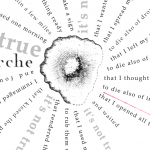electropoetics
Is Third Generation Literature Postweb Literature? And Why Should We Care?

Alex Saum-Pascual on e-lit's relocation to platforms with massive user bases, and the beauty of meh.
Grappling With the Actual: Writing on the Periphery of the Real

Like many of the "Artistic Reflections" featured in the Cork 2019 e-lit conference, Carpenter's opens out from her own web based works to a "post-digital world, in which invisible layers of data inform our daily thoughts and actions; a post-human world, of vast oceans and ceaseless winds."
Screen Capture in Digital Art and Literature: Interrogating Photographic, Interface, and Situatedness Effects

Christelle Proulx argues that screen captures in art and literature projects introduce three different effects on the representation of online world and its relation to offline world. The spatiotemporal specificities of the images produced are first considered through the photographic as a category of thought, then the importance of location is interrogated via the situated knowledges of Donna Haraway (1988) and concludes on the interface effects of this kind of imaging practice.
To Hide a Leaf: Reading-machine for a Book of Sand

Working with a custom-coded, automated-art-system of their own devising, Australian digital artists Karen Ann Donnachie and Andy Simionato have now archived a literary corpus for future study in what they have called The Library of Nonhuman Books. Yet it remains uncertain whether human scholars will visit Donnachie's and Simoniato's virtual library. Seeing as how "there are no human ‘typewriters’ now, how can we be sure there will still be human ‘readers’ in the future?"
Po/ética Trashumante y Resistencia en Dos Proyectos Digitales: de Negro en ovejas a Emblem/as

Elaborating on interspecies and translab experimentation. Escaja's interactive digital arts projects reclaim the notion of “transhumant,” a single term for nomadic practices that are shared by both the livestock and its shepherd. Both projects, Negro en ovejas (ovine poem) and Emblem/as, prioritize dislocation and nomadic multiplicity, which constitute a basis for resistance to and reconsideration of monolithic notions and canonical impositions.